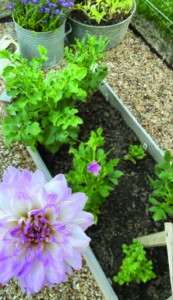Growing DAHLIAS in Louisiana
by BECKY CUNNINGHAM
 In the gardening world, dahlias have become the most coveted flower in the last few years. The wide range of colors, shapes, and sizes raise the average garden to another level. Last year I gave dahlias a trial run by purchasing a potted plant from a local nursery. To my surprise, it continued to bloom beautifully through the hottest part of our Louisiana summer. After researching more about these amazing blooms, I decided to plant dahlia tubers (similar to bulbs) this spring. And oh my goodness! It has been the most rewarding garden adventure so far!
In the gardening world, dahlias have become the most coveted flower in the last few years. The wide range of colors, shapes, and sizes raise the average garden to another level. Last year I gave dahlias a trial run by purchasing a potted plant from a local nursery. To my surprise, it continued to bloom beautifully through the hottest part of our Louisiana summer. After researching more about these amazing blooms, I decided to plant dahlia tubers (similar to bulbs) this spring. And oh my goodness! It has been the most rewarding garden adventure so far!
Several online nurseries offer dahlia tubers that ship to your home when the planting season begins. My tubers arrived in March from dahlias.com which is Swan Island Dahlias, located in Oregon. This family-owned dahlia farm grows over 370 varieties and ships high quality tubers all over the world. Open to the public for viewing and shopping, they have been in operation for over 93 years! The tubers are packaged in separate bags with tags for labeling after planted. Each tuber is stamped with the name on the tuber…with the most intriguing names, such as Mikayla Miranda, Lady Liberty, and Marionberry Milkshake.
 Planting tubers is a simple process. Start in mid-March, after the ground has reached 60 degrees or warmer. The ideal area is in an existing flower bed, or a raised garden bed that receives at least six hours of sunlight daily. Especially in Louisiana, early sun and late afternoon shade makes an ideal growing situation. Be sure to water deeply three times a week, for optimum blooms. It is best to plant dahlia tubers directly into an existing flower bed. However, if you start a new raised bed, be sure to use soil free of fertilizers or herbicides. Cow manure low in nitrogen is a safe soil additive rich in nutrients…just be certain to use sparingly. Be careful, as most composts are high in nitrogen and promote smaller blooms and spindly, weak plants. Bone meal is a safe additive during the planting process.
Planting tubers is a simple process. Start in mid-March, after the ground has reached 60 degrees or warmer. The ideal area is in an existing flower bed, or a raised garden bed that receives at least six hours of sunlight daily. Especially in Louisiana, early sun and late afternoon shade makes an ideal growing situation. Be sure to water deeply three times a week, for optimum blooms. It is best to plant dahlia tubers directly into an existing flower bed. However, if you start a new raised bed, be sure to use soil free of fertilizers or herbicides. Cow manure low in nitrogen is a safe soil additive rich in nutrients…just be certain to use sparingly. Be careful, as most composts are high in nitrogen and promote smaller blooms and spindly, weak plants. Bone meal is a safe additive during the planting process.
Plant tubers approximately six inches deep in soil, with the eye of the tuber facing up. Sometimes the eyes have a small sprout already growing and is easy to identify. Tubers need 12-24 inches between each one for adequate growth, as each one can grow to be 18 inches or more in diameter. There is no need to water the tubers until they begin to sprout above the ground. The sprouts may take up to four weeks to appear. When sprouts appear, apply a slug bait around the new growth to protect the plants from being eaten by slugs.
Before the sprouts get to be a foot tall, be sure to add some type of staking device. Dahlias can reach up to 4-5 feet in height and will need steady stakes to hold up the tall, heavy blooms. When plants reach approximately 12- 16 inches tall, be sure to pinch (or snip) the very middle, tallest stem…as this encourages fuller, stronger growth, and an abundance of blooms. During the blooming season, be certain to add a low-nitrogen, bloom food each month. This will encourage dahlias to thrive throughout the summer into fall.

Speaking of blooming season…approximately eight weeks after planting, the magic happens. Buds begin to appear! Then, in a few days they open into beautiful dahlia blooms. Some varieties have dinner plate size flowers!
No matter the size, the intricacies of the blooms are delicate and so unique. I am pleased to report they are as stunning as the photos depict. I planted a mix of purple and white dahlias…dwarf, small pom-pom, and large blooms too. The dahlias will continue to bloom until the first frost. The anticipation of the blooms is a lesson in patience. However, once the first bloom opens, it is worth the wait!









